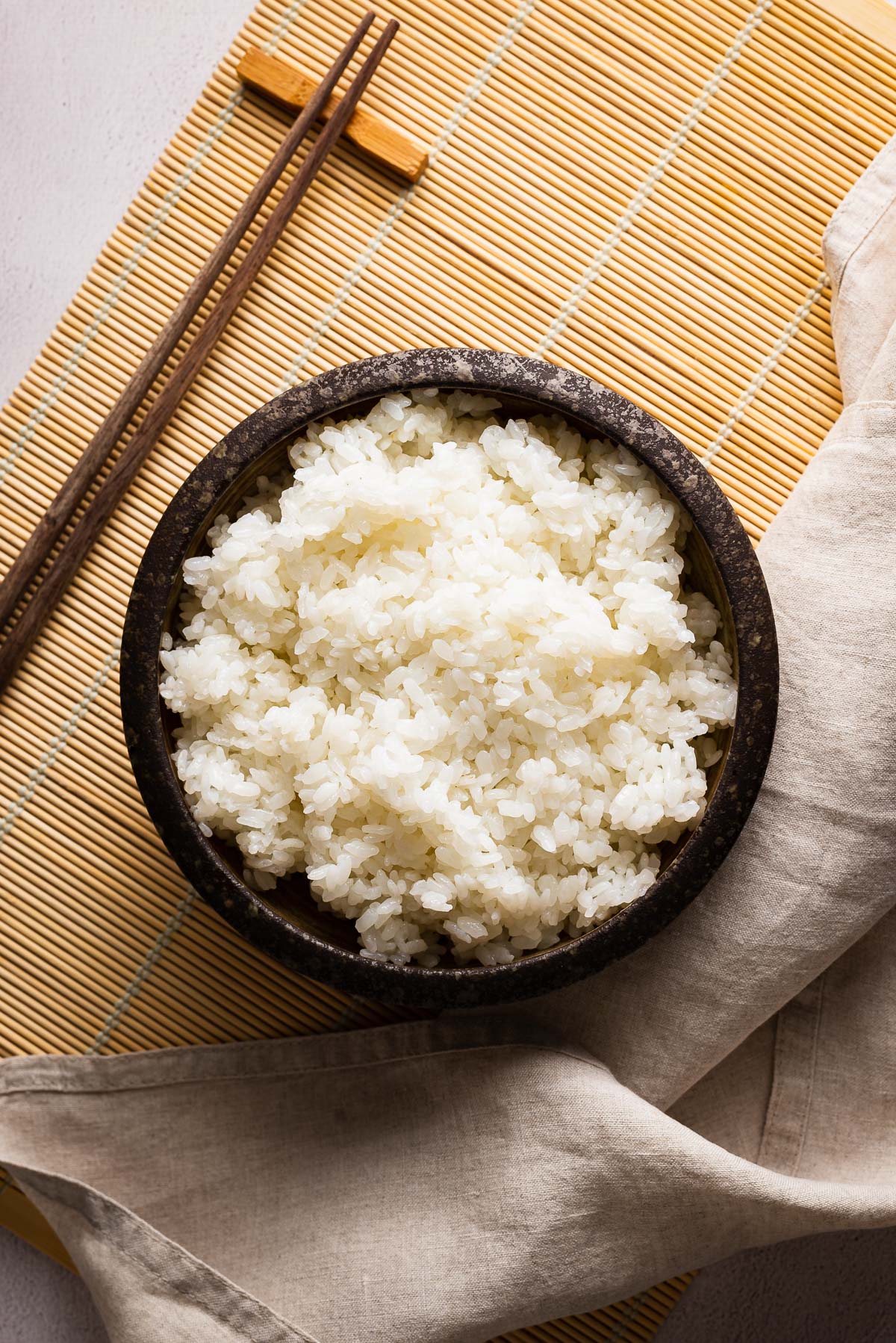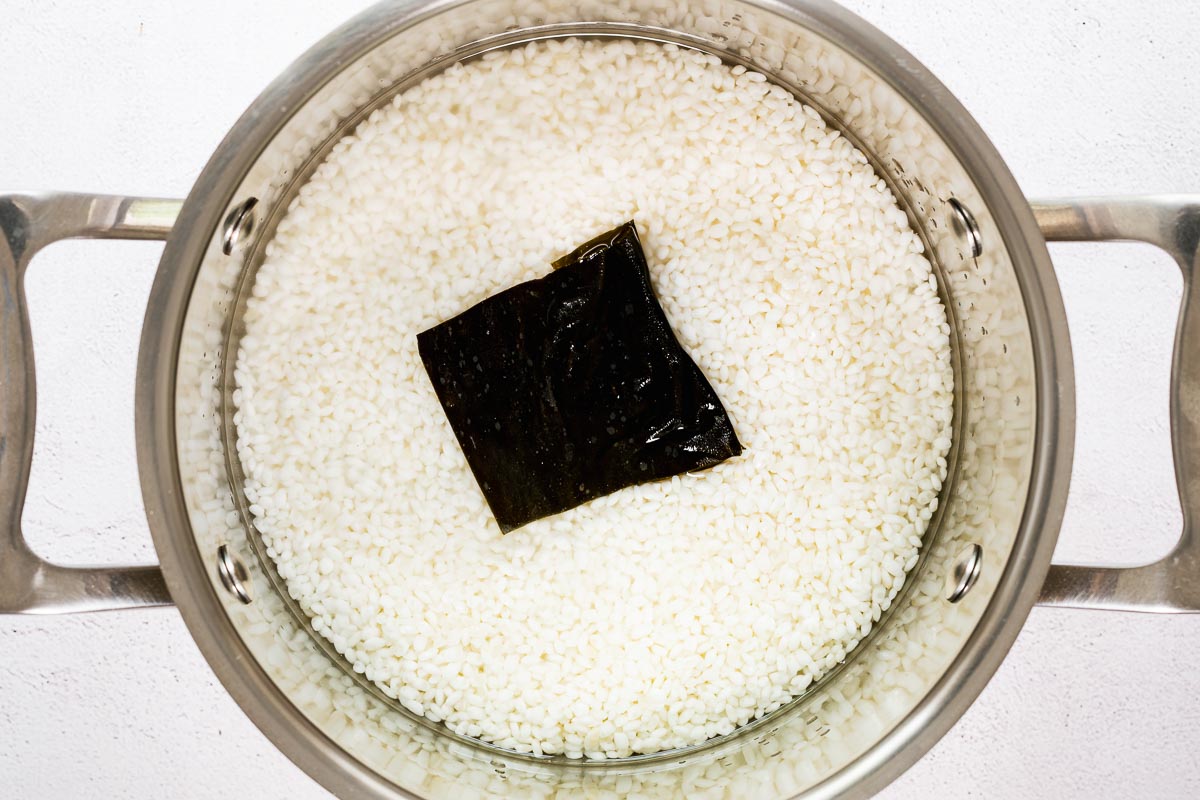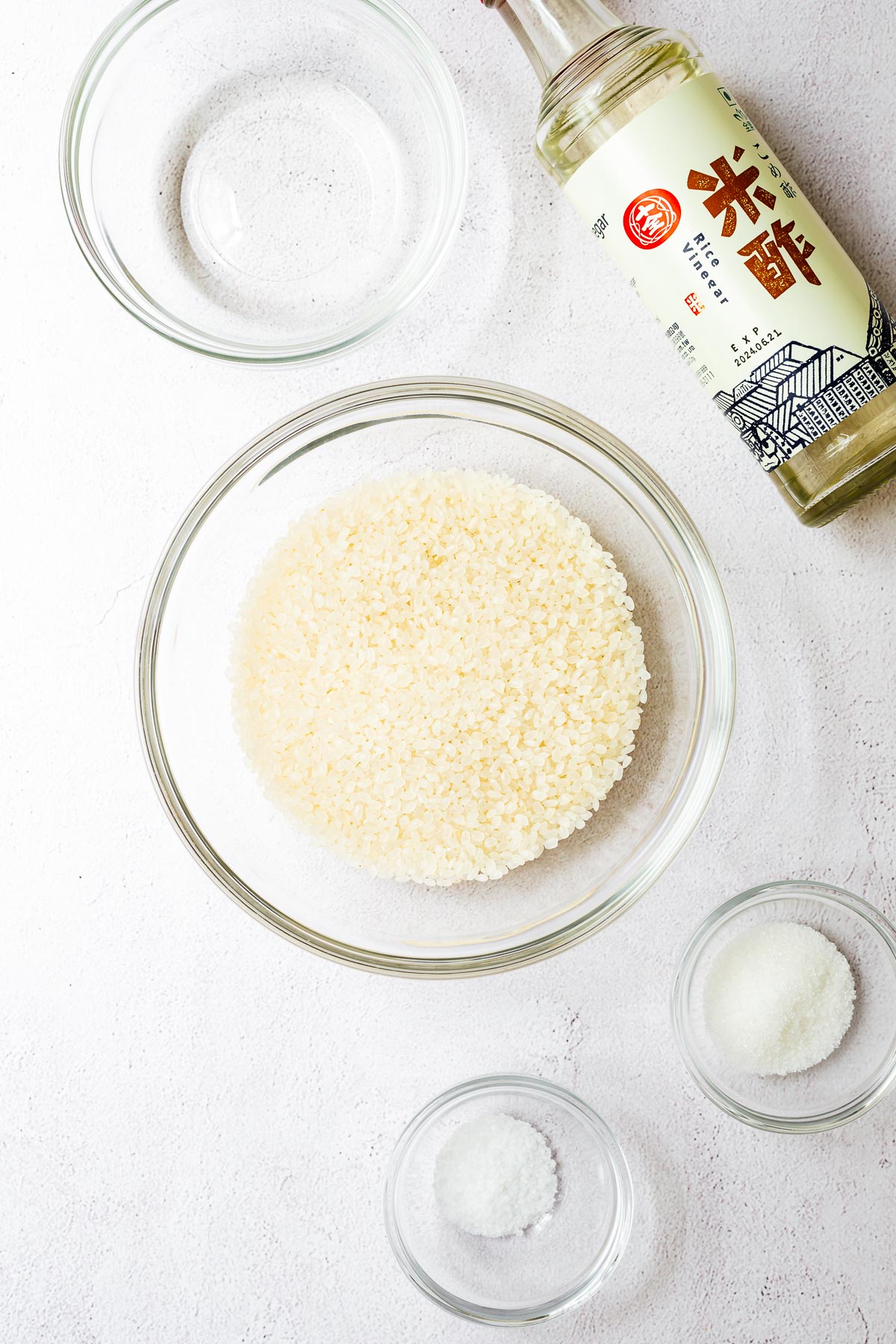How to Cook Sushi Rice (Easy Stovetop Recipe)
Cook perfectly plump and sticky white rice with this stovetop sushi rice recipe. Skip the sushi vinegar for a delicious bowl of warm Asian steamed rice, or follow all the steps for perfectly seasoned sushi rice.
This stovetop sushi rice recipe makes perfectly plump, sticky yet fluffy short-grain rice every time. It also works for medium-grain rice (like Calrose rice).
Add sushi vinegar to use the sticky white rice for homemade sushi rolls or hand rolls. Or skip the vinegar and use your perfectly cooked white rice for onigiri, poke bowls or as a side dish with Korean or Japanese meals.
Keep reading for everything you need to know to cook perfect short-grain or medium-grain rice on the stove (or in a rice cooker). Or jump straight to the easy sushi rice recipe.

What rice should I use for sushi?
The first step toward perfect sushi rice is choosing the right rice.
The Japanese rice used in everyday Japanese cooking is a short-grain cultivar of Japonica rice called uruchimai. It’s also the rice used for sushi and onigiri (Japanese rice balls).
Don’t confuse sushi rice with glutinous rice (mochigome). Mochigome is for mochi rice cakes and glutinous sweets. While it’s also Japanese short-grain rice, glutinous rice and sushi rice are not interchangeable. Glutinous rice is much stickier and chewier.
Calrose rice, the medium-grain rice popular with Japanese American producers in California, also makes good sushi rice.
Avoid long-grain rice (like jasmine rice or basmati rice) for sushi. It has a lower starch content and won’t produce the sticky texture required for making sushi.
This stovetop sushi rice recipe works perfectly with short-grain and sticky medium-grain rice. You can also make Instant Pot sushi rice (which does not require soaking the rice).
What do I need for sushi rice?
I often make sushi rice in the Instant Pot because it is faster, requires no soaking and requires less attention.
But this stovetop sushi rice method is how I cook all short-grain and medium-grain rice when I don’t have a pressure cooker around or if the power is out. (Not having electricity is a thing where I live, so I get more than enough practice with the gas stovetop.)
Equipment
- Large bowl: A large glass bowl works well to wash the rice.
- Mesh strainer: Any fine mesh strainer works well to catch stray rice kernels as you rinse it. Otherwise, use cupped hands.
- Rice paddle: I use a plastic rice paddle, but you can use any flat non-metal tool to stir the vinegar mixture through the cooked rice in a slicing motion. Try a rubber spatula or a flat wooden one.
- Hangiri (optional): This is the large wooden bowl used for mixing vinegar into cooked rice for traditional Japanese sushi rice. I just reuse the glass bowl I used for washing the rice. You can use any large non-reactive bowl.
- Damp tea towel: The kitchen towel is essential to keep the rice from drying out as it cools.
- Heavy-bottomed pan with a tight-fitting lid: The heavy bottom distributes heat evenly, and the tight-fitting lid lets the rice steam. But you can use what you have. You may need to adjust the cooking time or add more water if the lid does not seal well.
Alternatively, you can use a rice cooker instead of the stovetop method. The washing, soaking and resting steps are the same.
The rice cooker instructions in the recipe card are adapted from Jean’s perfect white rice recipe in Korean American by Eric Kim.

Sushi rice ingredients
- Sushi rice: Look for rice labelled as sushi rice or Japanese short-grain rice. Korean short-grain rice also works, as does medium-grain Calrose rice.
- Kombu (optional): The dried edible kelp is an optional extra to season your sushi rice as it cooks. Kombu, or konbu, is available in most Asian supermarkets.
Sushi vinegar ingredients
You only need the sushi vinegar if you use your rice in sushi. If you want a simple bowl of perfectly cooked short-grain rice, omit the rice vinegar and sugar. Add the salt to the cooking water with the uncooked short-grain rice, or leave the salt for unseasoned white rice.
- Unseasoned rice vinegar: Use unseasoned rice vinegar to craft the perfect balance of savoury, sweet and acidic.
- You can also use shop-bought seasoned sushi vinegar – omit the sugar and salt from the recipe.
- If you don’t have rice vinegar, you can dilute white wine vinegar with a splash of water as a substitute. But it’s worth keeping rice vinegar around if you plan to cook Asian food often.
- Sugar: Normal granulated white sugar is all you need, but you can use castor (superfine) sugar to dissolve faster. Or use your preferred sugar alternative.
- Salt: The coarseness of your salt influences the salinity of the sushi vinegar. I never use shop-bought fine salt with anti-caking agents (like table salt or some brands of fine sea salt). My salt has a coarsely ground texture. Use ¾ teaspoon (instead of a whole teaspoon) if you’re worried about overseasoning.

Tips for perfect stovetop sushi rice
The recipe card has detailed instructions for washing and cooking sushi rice on the stove or in a rice cooker, so I won’t bore you with those details now. But there are a few important steps worth highlighting.
Use the right type of rice
You can only achieve the perfect firm yet sticky rice with the right type of rice. Japanese short-grain rice or rice labelled as “sushi rice” (even if it is medium-grain rice) has a higher starch content that keeps your rice from falling apart. It is the best rice for sushi.
This recipe also works for Korean short-grain rice (mepssal) or medium-grain Calrose rice.

Wash the rice
Washing your rice removes impurities and extra starch to avoid mushy rice.
To wash the rice, place it in a large mixing bowl and cover it with cool water. Curl your fingers into a claw shape and gently swirl the rice.
Pour off the water over a mesh strainer or cupped hands to catch any runaway rice kernels. Repeat four to five times until the water starts to run clear. It doesn’t need to be perfectly crystal clear.

Don’t skip the soaking
Soaking allows for evenly cooked rice.
For stovetop cooking, soak the rice directly in the saucepan with a 1:1 ratio of water to rice. And if you use a rice cooker, you can soak it in the inner pot.
After soaking, the rice kernels will turn opaque.

Rest the cooked rice
At the end of the cook, leave the rice in the covered pot or rice cooker to steam for ten minutes.
It is part of the cooking process. Don’t skip it!
After resting, transfer the rice to a large non-reactive bowl, like a glass bowl. Or use a baking sheet covered with parchment paper to speed up the cooling. Avoid contact with metal bowls (or metal spoons).
Stir your sushi vinegar through the warm rice. Use a rice paddle and a slicing motion to avoid crushing the rice. (Skip this step if you want simple steamed white rice to serve with Asian stews.)

Cover the rice with a damp tea towel
Cover the rice with a damp towel to keep it plump and moist as it cools to room temperature.
Don’t refrigerate the rice. It will dry out and harden your perfectly plump sushi rice. Cooked rice is best used for sushi as soon as it reaches room temperature.
How to season rice for sushi
Sushi rice is vinegared short-grain rice. The sweet, savoury vinegar mix of sugar, salt and rice vinegar gives sushi rice its characteristic flavour.
How to make sushi vinegar
I use a 6:3:1 ratio of unseasoned rice vinegar to sugar to salt for my sushi vinegar mixture. You can play around with this ratio the next time you make sushi rice. But this ratio is perfect for me.
Use two tablespoons of rice vinegar with one tablespoon of sugar and a teaspoon of salt for each US cup of uncooked rice (two heaped cups of cooked sushi rice).
Gently heat the sushi vinegar ingredients in the microwave or a saucepan. And don’t allow the vinegar mix to boil.
You can make a large batch of sushi vinegar and refrigerate it. Or buy ready-made sushi vinegar.

Gently mix the sushi vinegar into warm rice
Use a rice paddle or silicone spatula to mix three tablespoons of sushi vinegar for every US cup of rice.
Gently fold the vinegar mixture through the rice in a slicing motion, carefully coating each grain of rice with the sushi vinegar.
Skip this step if you plan to use your rice for onigiri or as a simple side. Instead, sprinkle the rice with a teaspoon of salt or rice seasoning (furikake).
If you want to find your perfect ratio of vinegar to rice, make a large batch of the sushi vinegar mixture – it keeps well in the fridge. Add two tablespoons of vinegar to your cooked rice. Taste, and add more vinegar, one teaspoon or so at a time, until you’re happy with the taste.

How to use sticky sushi rice
Vinegared rice is traditionally only used for sushi. Even onigiri (Japanese savoury rice balls) use unseasoned short-grain rice.
But I adore the perfectly seasoned vinegared rice. It is sweet and savoury with a slight acidic kick.
Use your vinegared sushi rice for:
- homemade sushi rolls and hand rolls:
- try these easy avocado sushi rolls (hosomaki), or
- learn how to roll inside-out sushi rolls (uramaki).
- deconstructed sushi bowls (perfect when you are too lazy to roll sushi),
- a warm side dish sprinkled with sesame seeds and soy sauce,
- or delicious poke bowls.
Use sticky white rice without sushi vinegar for onigiri.
Serve it as part of a Korean dinner spread with dishes like Gochujang tofu (spicy Korean braised tofu) and sesame broccoli banchan. Or enjoy it for breakfast with a fried egg (gyeran bap).
And leftover short- or medium-grain rice is perfect for gochujang fried rice.

Equipment
- Large saucepan – with a tight-fitting lid.
- Rice paddle or silicone spatula
Ingredients
- 1 cup sushi rice*
- 1 cup water
- piece of dried kombu (optional), about 5 cm (2 inches) square
Sushi vinegar ingredients (for sushi rice)*
- 2 tablespoons unseasoned rice vinegar*
- 1 tablespoon sugar
- 1 teaspoon ground sea salt
Instructions
Rinse the rice
- Place the rice in a large mixing bowl and cover it with cold water. Swirl the rice with your fingers shaped like a claw. Don’t crush or break the rice. Pour off the water, and repeat four to five times – until the water runs clear.
Soak the rice
- Place your rinsed rice in a medium-sized saucepan or pot for which you have a tight-fitting lid. Add a cup of water and gently stir to distribute the rice. And set the pot of rice aside to soak for 20 minutes.
Mix the sushi vinegar (only required for sushi)
- Gently heat the sushi vinegar ingredients.
- In the microwave: Place the rice vinegar, sugar and salt in a small microwavable bowl and heat for 30 seconds.
- On the stovetop: Use a small saucepan to heat the rice vinegar, sugar and salt until it just starts to simmer. Don't let it boil.
- Stir until the sugar and salt dissolve.
Add kombu (optional)
- Place the kombu on the surface of the rice. Add an extra tablespoon of water to accommodate the rehydration of the kombu.
Stovetop instructions
- Move the pot with the rice, water and (optional) kombu to the stovetop over high medium-heat until the water just starts to simmer – about 3 minutes. Cover the pot and turn the heat down to low, maintaining a gentle simmer.
- Allow to simmer for 10 minutes or until the water is absorbed (it will look and sound dry).
- Let the rice rest for 10 minutes with the lid. This allows the rice to steam. It is part of the cooking process, so don’t skip it. And definitely don’t lift the lid while the rice steams.
Season the cooked rice with sushi vinegar (only required for sushi)
- Discard the kombu and transfer the cooked rice to a non-metal bowl (traditionally wood, but glass works just fine).
- Add the seasoned vinegar mix to the warm rice. Gently fold it through the rice with a rice paddle in a slicing motion to combine, carefully coating each grain of rice with the mixture.
- Cover the rice with a clean damp kitchen towel and allow it to cool to room temperature – about 30 minutes.
Notes
- This recipe also works for Korean short-grain rice or medium-grain Calrose rice.
- Rice cooker instructions: Add the cup of washed rice to the inner pot of your rice cooker. Add a cup of water and soak the rice for 20 minutes. Then start the rice cooker. When the cooking time is over, allow the rice to rest in the rice cooker for 10 minutes. Rice cooker instructions were adapted from Korean American: Food That Tastes Like Home by Eric Kim.
- You can also make sushi rice in a pressure cooker, see Instant Pot sushi rice for step-by-step instructions.
- Skip the sushi vinegar and fluff the rice with a fork for perfectly steamed white rice. Serve it warm or at room temperature.
Try more Asian recipes to serve with sticky white rice:
